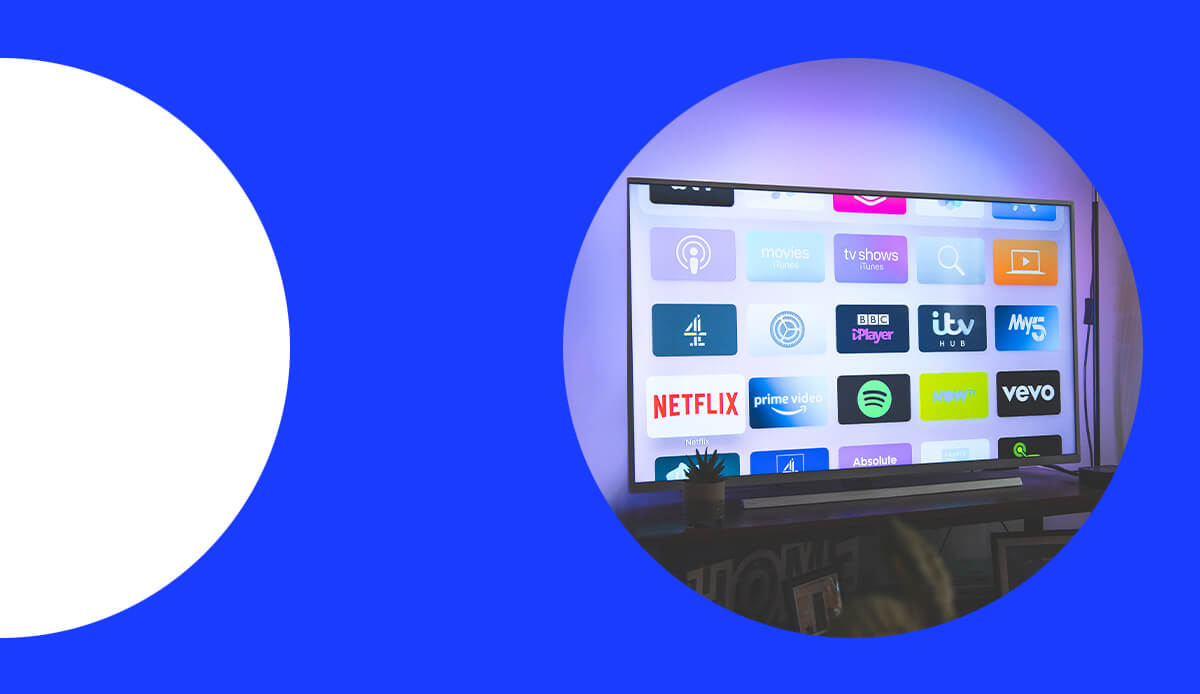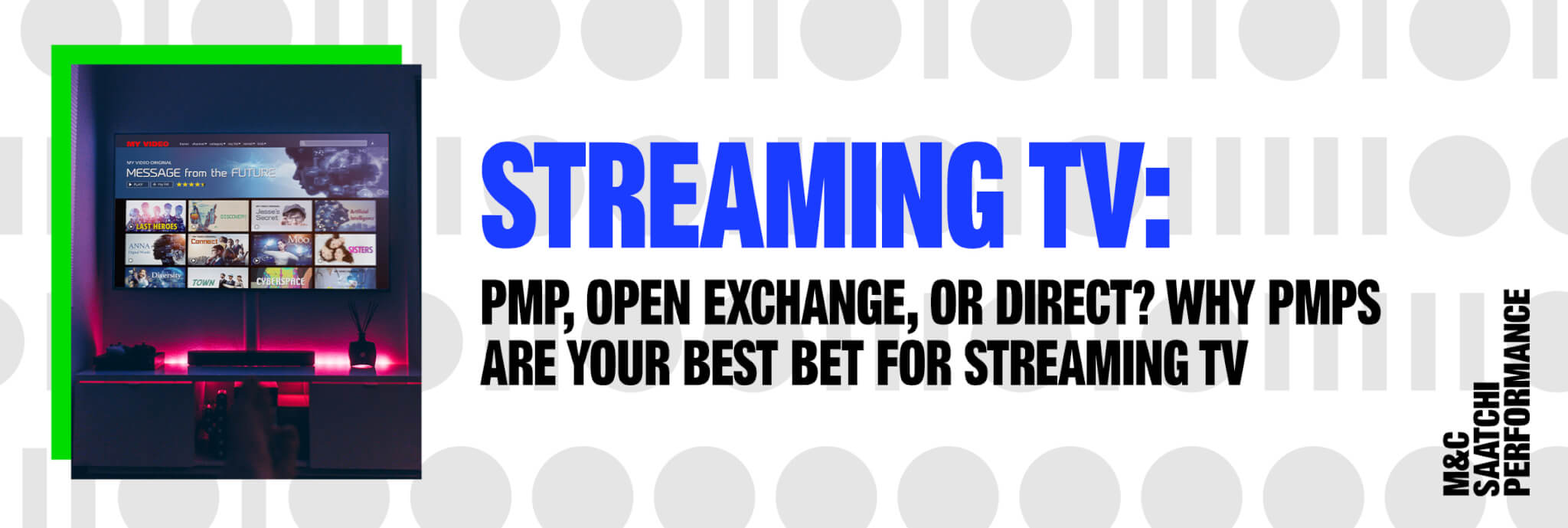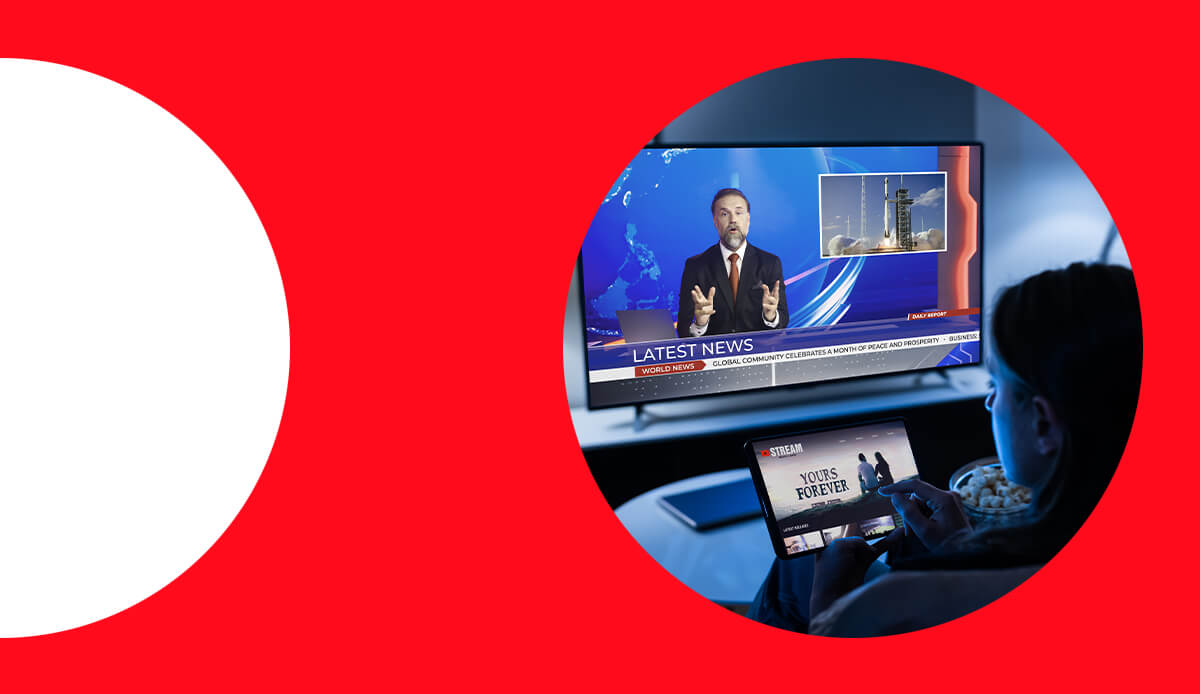
Private Marketplace, Open Exchange, or Direct? Get the lowdown on the best ways to buy streaming TV inventory, and find out why PMPs are a good bet for buying streaming TV

Audiences across the USA spend nearly two hours a day watching ad-supported video-on-demand services through smart TVs and other connected TV (CTV) devices. Advertisers are rushing to meet this increased demand and are expected to spend nearly $38 billion on streaming TV advertising by 2026.
When launching a streaming advertising campaign, it’s important to optimize the reach of your ad dollars through the purchase of high-quality streaming TV inventory and the use of robust testing and targeting features. That’s why finding the right marketplace is ideal — there are several options available, and they’re not all created equal.
Direct deals: Negotiate directly with the publisher
Direct deals are a legacy offering that originated from traditional linear TV advertising, and they operate as they sound. Advertising firms communicate directly with the publisher to negotiate a price on a set amount of inventory. Once both parties agree on a price, the publisher delivers ads to viewers.
These deals usually happen in bulk — advertisers buy a set amount of streaming TV inventory, which will run a certain amount of times or over a specific time frame.
Pros:
- Premium access to select inventory: Streaming networks like Hulu and Paramount+ serve millions of viewers. Signing a direct deal with these publishers ensures ads are given prime positioning across their premium offerings.
- More customization: Many publishers are experimenting with bespoke interactive features and other custom offerings, and working directly with them allows advertisers to craft unique content to fit the platform.
Cons:
- Limited to publisher ecosystem: When signing a direct deal, the agreement is made with that publisher directly — meaning ads are limited to that publisher’s offerings. For example, signing a deal with Amazon means ads appear on networks like Freevee or Twitch, but they won’t appear on Peacock because a separate publisher owns that channel.
- Prices are subjective: Direct deals are negotiated directly with the publisher, meaning prices vary on a contract-by-contract basis. Some advertising firms may get better deals based on how long they’ve worked with the publisher, purchase volume, inventory type, or any number of other factors.
- Inflexible: Once a deal is made and the campaign has begun, advertisers remain largely hands-off until the deal has finished. The ability to make creative adjustments is rare, and publishers usually provide reporting after a campaign ends.
Best for: Large global brands with experience in the streaming TV ecosystem.
Private Marketplace: Curated and automated
Private Marketplaces (PMPs) are custom-created programmatic auction deals activated through a specific publisher or via supply-side platforms (SSPs). PMPs are made available to a curated list of publishers, who are able to select from an exclusive slate of premium inventory.
Streaming TV advertising works by combining demand-side platforms (DSPs) and supply side platforms (SSP). On the DSP side, advertisers select targeting parameters based on audience, content, and other factors and set a maximum price they’re willing to pay.
When a viewer watches streaming TV content, their streaming device will make an ad request to the SSP. The SSP and DSP communicate with each other and start a round of real-time, automated bidding for the ad request. The highest bid wins the request, and the ad is delivered to the viewer. This entire process only takes a handful of milliseconds. DSPs then provide reporting to the advertiser, allowing them to capture data on campaign success and make adjustments to creative or audience targeting as needed.
Pros:
- Curated and diverse inventory: Unlike open marketplaces, PMPs are invite-based, providing ad inventory access to a select group of reputable advertisers. This selective process allows performance marketing agencies like M+C Saatchi Performance to curate vetted, brand-safe inventory through these PMPs and align with relevant environments in which the target audience may over-index.
- Hands-on reporting and targeting: Programmatic streaming TV offers insight into performance data that linear TV can only dream of and that direct deals usually don’t provide until the end of a campaign. Compare performance with A/B testing and track the results in real-time, then make adjustments to creative and targeting to optimize performance mid-campaign.
- Transparent pricing: Supply and demand govern PMP bidding values, and the advertiser sets the maximum amount they’re willing to spend, ensuring a fair and open process that levels the playing field for everyone.
Cons:
- Cost: Due to high demand, some publishers may implement a fixed CPM or require an upfront budget commitment to access premium inventory for guaranteed ad impressions.
Best for: Most advertisers and streaming TV newcomers
Open exchange: A public free-for-all
Open exchanges operate similarly to PMPs, but the main difference is that all advertisers and suppliers have access to it. This freedom may seem like a great option for advertisers looking to dip their toes into streaming TV, but they carry risks.
Pros:
- Easy access: The open exchange is accessible by anyone who wants to buy or sell CTV inventory. Negotiating a special deal or working with a PMP isn’t needed.
- Lower cost: While the inventory isn’t as high quality as that found with direct deals or PMPs, it’s not as expensive.
Cons:
- Lower-quality inventory: Inventory found on the open exchange tends to be leftovers that didn’t sell on the PMP, as well as inventory from other suppliers who aren’t working with PMPs for one reason or another. As a result, the inventory available is generally less desirable.
- Greater potential for ad fraud and brand risk: Because of its open nature, there’s no vetting process for suppliers, leaving advertisers far more exposed to brand risk or ad fraud. Purchase inventory on the open exchange with extreme caution.
Best for: Advertisers looking to save money and can weather the risk
Our recommendation: Test PMPs for their quality inventory and agile platforms
Whether you’re new to the streaming TV landscape or a programmatic veteran, we recommend using Private Marketplaces because of their versatility, quality inventory, and robust optimization features.
Working with a partner like M+C Saatchi Performance will ensure you get the best bang for your advertising buck with efficient targeting across a streamlined campaign management system. You’ll get full access to data, unprecedented control over where ads are displayed as well as who they’re reaching, and the ability to update creative mid-campaign to optimize its strengths. Plus, inventory is properly vetted before purchase, giving you peace of mind knowing that your brand is safe across the private marketplace.
Get a headstart on your CTV campaign
At M+C Saatchi Performance believe in a data-driven approach guided by a human touch, and we want to arm marketers with the information they need to succeed in the exciting streaming TV landscape. We’ve worked with prominent CTV players like Roku, Samsung, tvScientific and AppsFlyer to create The Definitive Guide to Programmatic Streaming TV for Performance Marketing — a one-stop-shop guide through everything you need to know about launching your streaming TV campaign. Download the report today, and discover how programmatic advertising through streaming TV can boost ROAS, and increase brand lift across your entire marketing mix.

